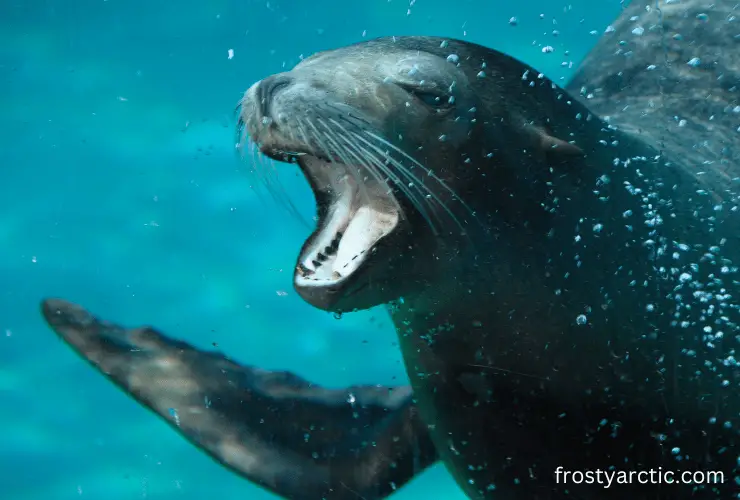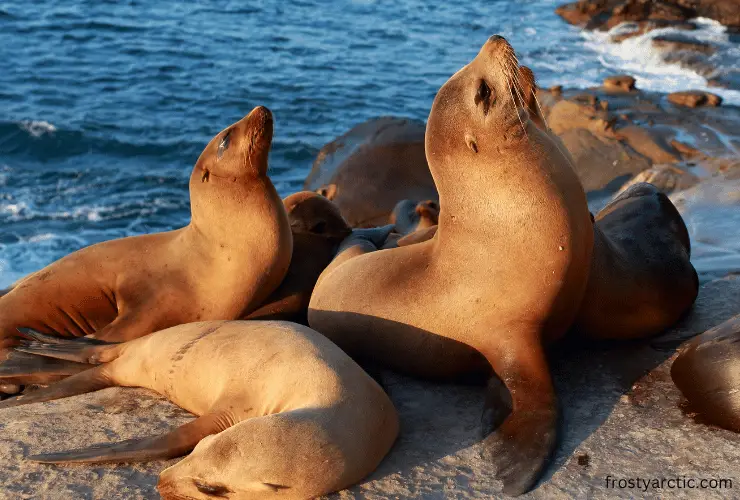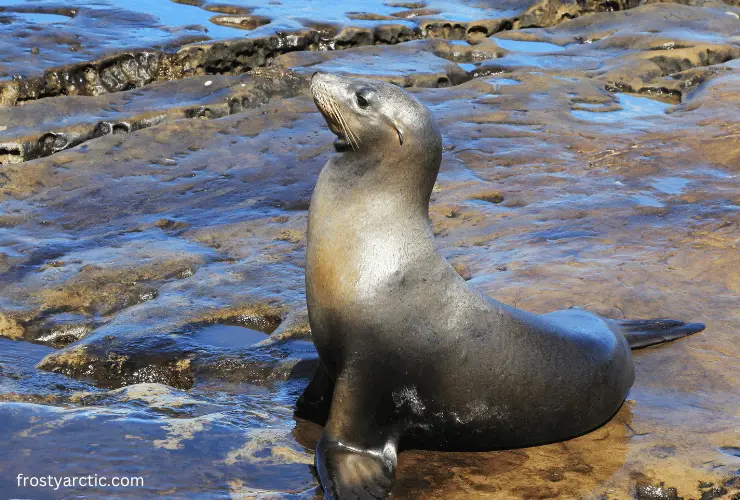Sea lions are well known for their loud vocalizations that can be heard from miles away. These pinnipeds are a social species and use their distinctive barks, grunts, and roars to communicate with each other. Their noisy behavior serves a variety of purposes, including defending territories, attracting mates, and coordinating group hunting efforts.
These noisy sea lions have highly developed vocal cords. They can produce a range of complex sounds, including trills, clicks, and even songs. They also have excellent hearing and can communicate underwater using sonar-like vocalizations.
Sea lions also use vocalizations to express emotions, such as aggression or contentment, and to locate each other in crowded rookeries.
In this article, we’ll explore the fascinating world of sea lion communication and learn about the different sounds they make, why they make them, and how they use them to survive in their ocean environment. So, let’s dive in and discover what makes these charismatic creatures so vocal.
Why Are Sea Lions Noisy? Lets’ Discuss the Report of Research Journal

You would have heard the voices of sea lions in the sea. Dosits organization authors have found the following interesting reasons behind the barks and vocalizations of sea lions:
“Sea lions are highly vocal and use a variety of sounds to communicate with each other. Underwater calls are used for establishing and defending territories. These are also used as asserting dominance during the breeding season. These calls include:
- Barks
- Whines
- Buzzing Sounds
- Click trains
Above the water, sea lions produce a wider range of calls, some of which are transmitted into the water. Even on land, sea lions continue to make calls. Male sea lions bark loudly to defend their territory and attract potential mates. During mating, they also use barking as a means of communication.
In contrast, female sea lions make a variety of sounds including barking, squealing, belching, and growling when they feel their pups are in danger. Interestingly, female sea lions and their pups can recognize each other’s calls. (Each pup and female has a unique scent that identifies them from others.)” (Source)
According to the National Oceanic and Atmospheric Administration, all species of sea lions make noise, either the California sea lion or the Steller sea lion. (Source)
Mother-Pup Recognition Sequence
Sea World source has explained the special behavior called mother-pup recognition sequence in the following words: (source)
“Female California sea lions use a distinctive vocalization to recognize their pups. This behavior is called the mother-pup recognition sequence. When returning to the rookery after feeding, the female emits a loud trumpeting sound, prompting a bleating response from her pup. This call-and-response pattern continues until they reunite. Mother and pup also use visual and olfactory cues to identify each other.”
Females become extremely aggressive just before and after giving birth. They use a series of threatening vocalizations that start with barks and progress to intense squeals, forceful belches, and irregular growls. Sea lion pups have two distinct vocalizations:
- A bleating call to recognize their mother
- A high-pitched alarm call
As they grow, their vocalizations mature into adult-like barks. In addition to the above-mentioned facts, sea lions exhibit highly social behavior on both aquatic and land surfaces.
These sea lions are also wary of mankind. They instantly escape into the water if they detect people through sight or smell.
Rafting Behavior

NOAA Fisheries research has found that male sea lions use barking sounds, similar to those produced by dogs, as a means of communication. The research has also explained a special behavior called “rafting” in the following words:
“Sea lions often engage in a behavior known as “rafting.” In this behavior, they float motionless on the water’s surface for extended periods, appearing as if they’re captivated through a fishing net. You will find the flippers raised upon the water surface during the rafting. It helps them to keep their body temperature balanced mode. If there are no visible buoys or fishing gear around, likely, the sea lion is just rafting.” (Source)
Why Do Sea Lions Make Noise at Night?
Sea lions make noise at night to convey messages to predators and humans to leave them alone. Sea lions use roaring as a defense mechanism to safeguard their territory when they sense danger. This vocalization is powerful enough to deter other animals and humans from approaching them.
Sea Lions are indeed capable of roaring. Some people may not believe it unless they witness it themselves. In case of feeling threatened, Sea Lions can increase the intensity of their roars. They are highly communicative animals, as many people who have observed them can attest to.
Sea lions produce a range of sounds, including honking and trumpet-like calls. Their sounds are used for communication and can captivate human observers. That’s why people love to watch them for hours and hours. These marine mammals are believed to possess exceptional hearing abilities both in and out of the water. Plus, they are active at night.
Sea Lions are highly social creatures and their communication is still not fully understood by researchers. Their communication plays a crucial role in their survival. In captivity, they must be kept with others for their mental well-being. (Source)
Sea Lion Vocalization

Sea Lions are difficult for researchers to study as they form large groups with constant communication. Despite this, observations have led to valuable insights. For instance, pups can recognize their mother’s sounds and calls instinctively, using both memory and smell to locate her.
Sea Lions produce loud trumpet sounds when they sense a threat to their harem or colony. This is a signal for all of them to flee to the water. The chaos that ensues during this time can cause the younger Sea Lions to get trampled. It shows the fact that they are responsible parents and caretakers.
A Wake-Up Call in Oak Bay of Barking Sea Lions: Interesting Study Report
Before discussing this topic, we would like to pay heed to the most important population behavior and habitat lifestyle of sea lions. Let’s see what it is according to the words of NOAA Fisheries:
“NOAA Fisheries categorizes California sea lions into different stocks:
- United States
- Western Baja California
- Gulf of California
The U.S. stock is situated between the Mexico or US border and Canada.
Usually, you will find California sea lions prefer to travel or migrate to the following states during snow time.
- The coats of Oregon
- southeast Alaska
- British Columbia
- Washington
- Oregon and
- The coast of California
However, you will find both baby sea lions and mother lions close to the breeding communities. Until the baby lions abandon taking milk, they remain close to breeding territories.
During summer times when the water temperature is high enough, some mother lions venture as far north as Washington and Oregon, possibly in search of prey.” (source)
Also, the researchers of the Scripps Institution of Oceanography’s website “Voices in the Sea” has found the following fun fact about sea lions:
“When onshore, California sea lions are highly sociable and can gather in groups of several hundred individuals.” (Source)
Now come to the local news given by Darron Kloster in the Times Colonist newspaper that states that “Hundreds of barking sea lions provide wake-up call in Oak Bay.” What does it mean? It means sea lions and harbor seals are gathering near Oak Bay due to an abundance of herring. Their loud barks and growls can be heard as far as Mount Tolmie. (Source)
Trial Islands off Oak Bay, Victoria, has become a hub for hundreds of California sea lions, Steller sea lions, and harbor seals since early December. These marine mammals can be heard barking and growling in Oak Bay. They are also waking people up in the predawn hours.
According to biologist Jacques Sirois, a healthy population of herring is what’s attracting these pinnipeds to the area.
Sirois, a participant guard at Trial Islands, counted sea lions and seals on a recent kayak trip. He spotted the following numbers of sea creatures:
- 150 California sea lions
- 5 Steller sea lions, and
- 300 harbor seals.
He believes this is the first time he’s seen mammals outnumber birds at Trial Islands. Plus, it’s the first time these creatures have awakened people in the morning (since 1997).
The abundance of herring around Greater Victoria is encouraging news, according to Sirois. Large amounts of herring have disappeared from the area over the past few decades. However, recent sightings of pinniped gatherings and massive flocks of gulls indicate a herring spawn in March that could be similar to or better than last year’s spawn.
Herrings are an important diet for seals and sea lions (especially California sea lions). Thus, they can survive in such areas for extended periods. Steller sea lions, in particular, can weigh up to 1,500 kilograms, while California sea lions average about 400 kilograms. At Trial Islands, you will find maximum sea lions migrating north from Oregon. They also migrate from California to Vancouver Island for food reasons.
Sirois said that Pacific herring are a “foundation species” on coastal British Columbia, with birds, larger fish, otters, seals, and humpback whales all feeding on them and their eggs. Millions of herring used to be in Victoria’s harbor, Gorge Waterway, and Portage Inlet. But the bad news is that fewer herring are seen in the area now due to overfishing.
Sirois is hopeful about the return of herring to Greater Victoria. He has recently seen herring balls up to 20 centimeters long at Ogden Point, which is larger than the usual 12- to 15-centimeter length. This sighting is a positive sign. The emergence of a plentiful supply of herring around Greater Victoria is welcome news. It is beneficial not only for marine mammals but also for the ecosystem.
Why Do Sea Lions Cry?

Numerous tales are circulating about Sea Lions appearing to shed tears. Sea lions have tear ducts to remove saltwater from their eyes, which leads to many stories of them crying. It’s just their natural way of expelling salt water from their eyes.
It helps them maintain clear vision underwater, which is crucial for their survival and hunting. Despite having decent eyesight, sea lions are believed to be nearsighted. Certain indications suggest that sea lions are better at seeing in the water than on land.
Sea lions may also cry due to physical irritations or infections in their eyes, just like humans. They may also cry due to irritation from sand or debris that enters their eyes, or due to an injury or infection. In these cases, the tears serve as a protective mechanism to flush out any foreign objects or harmful substances.
Why Do Sea Lions Bark Constantly?
Sea lions constantly bark when they are establishing territories. And when their territories are formed and established then, only the male sea lions bark incessantly to maintain and defend their territories. This is especially common during mating season. This reason (territory defense) is given by the ‘Sea World’ organization. Here are a few other reasons why sea lions bark constantly: (source)
- Warning signals: Female sea lions will bark, squeal, belch, or growl when their pups are in danger or threatened by predators.
- Socializing: Sea lions are social animals and use vocalizations to bond with each other, establish hierarchies, and locate other members of their group.
- Expressing Emotions: Sea lions also bark to express various emotions like happiness, frustration, and excitement.
We have already mentioned the reasons for attracting mates and communication in our first section.
Sound Production Behavior
Here are a few distinct and amazing facts about the ‘Sound Production’ behavior of sea lions given by SeaWorld: (source)
- Sea lions have vocal cords and use vocalization as their primary means of communication.
- California sea lions are very vocal, producing sounds above and below water.
- Their vocalizations include a variety of sounds, such as barks, growls, and grunts.
- They are considered to be one of the most vocal mammals.
- When not breeding, it is observed that submissive male sea lions tend to be more vocal than dominant males.
Effects of Noise on Sea Lions
Noise pollution can have detrimental effects on sea lions, and some of them are:
- Disruption of communication: Excessive noise can interfere with the sea lions’ ability to communicate with each other, causing them to miss important vocalizations, such as warning calls.
- Physical harm: Loud noises can damage the sea lions’ hearing, leading to long-term hearing loss or even deafness.
- Behavioral changes: Sea lions may exhibit changes in their behavior due to noise pollution, such as avoiding areas with high noise levels or altering their vocalizations.
- Habitat displacement: Noise pollution can cause sea lions to abandon their habitats or breeding sites, leading to a decline in population.
- Impact on health: Prolonged exposure to high noise levels can cause chronic stress in sea lions, which can lead to a weakened immune system, reduced reproductive success, and other health issues.
Thus, noise pollution can have serious and long-lasting effects on sea lions, affecting their communication, behavior, health, and overall survival. It is essential to minimize noise pollution in their habitats to protect these animals. (Source)
FAQs
What are sea lions saying when they bark?
When sea lions bark, they communicate with each other using vocalizations that are unique to their species. These barks can convey information about their location, status, and emotions, such as aggression or warning signals. Sea lions may also use other sounds, such as grunts, growls, and whines, to communicate different messages to their peers.
Can sea lions make noise underwater?
Yes, sea lions can make noise underwater. They can vocalize using a series of grunts, growls, and bellows, which they use to communicate with other sea lions and possibly to locate prey. Their vocalizations can be heard both above and below the water’s surface.
Conclusion
Sea lions are quadrupedal and vocal animals. They make a distinct barking sound, “ark, ark, ark.” They are frequently observed walking on land and communicating with each other using a range of grunts, growls, and bellows. Their distinctive vocalizations can often be heard from a distance.



1 thought on “Why Are Sea Lions So Noisy? [Explained]”